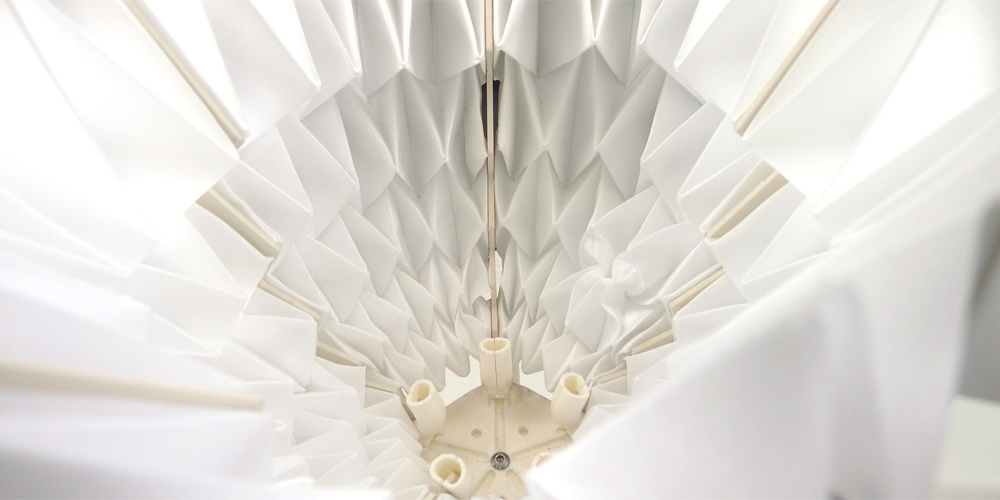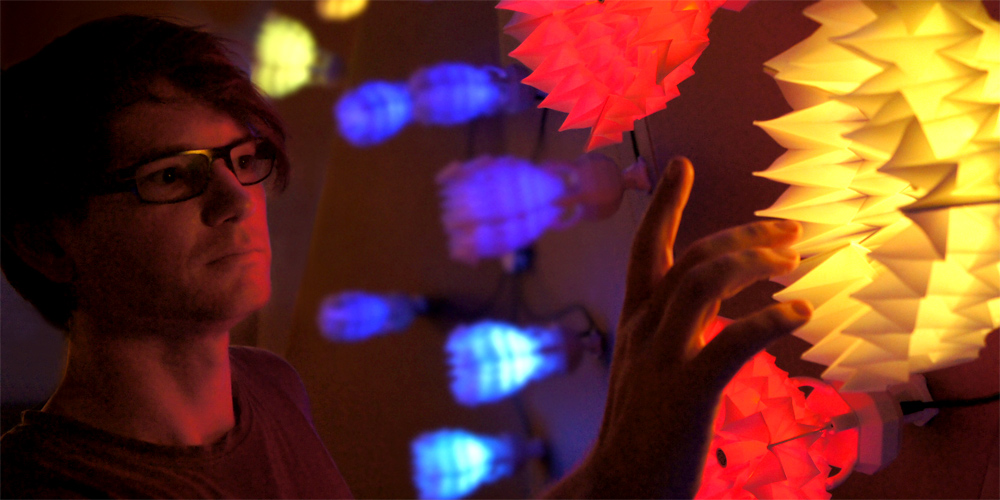There are lots of materials and things in our world—DNA, letters and mountains, for instance—that can be folded or are folded at certain places, regardless of how big those things are. Even as a little boy, artist Matthew Gardiner was fascinated by origami, the Japanese art of paper folding. Today, he’s an expert in oribotics, a field at the nexus of nature, origami and robotics. His research at the Ars Electronica Futurelab seeks new foldable surfaces. In May of this year, he was a guest at O’Reilly’s Solid Conference in San Francisco, where he delivered a speech entitled “Folding = Coding for Matter” that elaborated on the many possibilities inherent in various folding methods and the interesting prospects these could open up in art as well as several scientific disciplines.
Why is folding so important for the future of things?
Matthew Gardiner: I think the most important thing to understand about folding is that it’s not about just something to do with paper like origami but it’s something you can do to shape materials fundamentally. I use the term “to program materials”. And it’s not only man-made things like architecture, design, fashion and even design of new cars, but it’s also one of the main languages used by nature. You see it in protein folding, scientists study how proteins fold up their sequence to combine DNA and RNA to make new shapes. It’s like folding long strings in a way. I see it as a structural language. It’s also a language which gives function but for me as an artist I look at it from an aesthetic point of view. I make these incredibly beautiful seamless captivating detailed complex folded oribots that point to these new developments in understanding nature. The natural forms I use reference nature, the technology objects reference to the nature of folding.

The meaning of folding really shifted from the idea of origami as a craft over the last 20 to 50 years. It spread out of Japan after WWII and made it’s way to American communities through cultural exchange, and lately, the origami community started to develop the idea of origami science. This occurred as dedicated origami artists¬, who had day jobs like physicians or mathematicians. From these communities came ideas like the Huzita-Hatori axinoms of origami which is a set of mathematical statements that define the ways we can make fold. For example, if you have a flat material and you fold point A to point B, that defines the fold, the two points, the equal distance between them, and the angle that of the fold. The axioms are useful for straight line folds, and curved folds are a new area.
I’m really convinced that folding is a 21st century technology. It’s based on a whole spectrum of 21st century ideas – in biology, in mathematics, in our understanding of nature, in the types of aesthetics that we are drawn in architecture.
Folding could drive architects to use more and more natural shapes. When I read about the philosophy, Gilles Deleuze writes about The Fold, it changed the way I looked at buildings and other materials, now I see concrete and metals as kinds of folds and angles. Delueze writes a lot about the coils of the soul, to me, he is talking about DNA! At a certain point Deleuze’s ideas made me think: in the imagining of folds of the soul like a physical property, he also invokes the abstract metaphysical properties of the folded language of nature. If find this very fascinating – not only philosophically, but also to all of these other areas of science. It’s hard for me not to see these connections to all these different disciplines.
Matthew Gardiners keynote at the O’Reilly conference in May 2014.
At the O’Reilly conference you met a lot of people. What impression did you get about these communities?
Matthew Gardiner: Through conversations about my keynote talk and exhibition of oribotics I had many discussions around the sale of my artworks, many people want to have them. I had a discussions with a number of people who are experienced in fields of architecture, design and biology. There were excited telling me, I get it, you know what you are talking about. They could see these connections that I was drawing a line between. I had really convincing conversations with people whose backgrounds were broad enough in other fields, because while my background in biology is nearly zero, I learned so much, while curating the exhibition “Project Genesis” at the Ars Electronica Center, about synthetic biology. During this time I learned about the possibility to use DNA as a material – and the main mechanism is folding! You can fold shapes from DNA at the nanoscale.
So we are all folded…
Matthew Gardiner: Yes, I came to that point, that everything is folded. While that sounds nice and simple, it’s actually very complex. To me, folding is a factor that is fundamental in our universe. Of course it’s not everything that there is to say about it. The topic of folding has so many emerging connections to so many different disciplines. Not many people understand that. Like an architect who is using folding may not understand the relationship in biology. A biologist may have no idea that they are referencing the entire art history of folded forms.
The principle that drives their fascination is essentially the same: with one material, using only folds, we can make structures.
Origami is about sculpting anything, absolutely anything, using only folds, no cuts. DNA origami is about making any shape that we like using small pieces of DNA that are coded to self-fold and self-assemble. DNA has special properties to do with bonds between the molecular pairs, and some researchers discovered how to combine them so that they fold and form structures. I wonder if these researchers are aware of one another’s others work, but as an artist I’m not interested in one area in particular but rather I’m interested in the connections between them. The idea behind this is to give us an appreciation for when we see architecture, and we see many folded design objects, and I want to explain why they are attractive to us, and I think it’s because we are all folded? There is the possibility to underline this conceptual framework of folding, and that’s what I’m working on.
Matthew Gardiner presents his Oribotics
What are you currently working on?
Matthew Gardiner: At the moment I’m looking at a number of different angles, I’m exploring soft robotics, synthetic fabrics, resin and polymer casting of folded surfaces. I’m building on my theoretical framework, at the moment I see scale, material and dimension as being defining criteria for folding and technology. Alongside my material experiments, I do a lot of algorithmic design of objects, static studies of complex folded surfaces. These aesthetic developments are now becoming more mature in my artistic practice. My FWF-PEEK project „On the Aesthetics of Folding and Technology“ is about to commence, I’m excited to be working with the team in the Ars Electronica Futurelab to push the boundaries of this complex and diverse research field.
